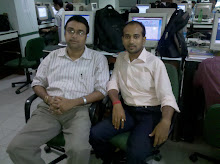May of us doing physical defragmentation to get the performance of SQL server and think that physical defragmentation after SQL server defragmentation. This is a absolutely wrong concept and to illustrate my points I have collected some facts.
Physical disk fragmentation
Physical disk fragmentation is likely what comes to mind when fragmentation is first discussed. Physical fragmentation is a side effect of how hard drives and Windows work. It is common knowledge that regular disk defragmentation is required to achieve optimal performance from your PC. Windows even includes a basic defragmentation utility.
Physical fragmentation slows down your PC because reading data is interrupted by head seek delay. Windows fits files into free space, often breaking the file into segments stored apart from one another. A hard drive's head relocates to read each individual segment. As it moves to each segment the head 'seeks' - often at a cost of 3-4 times the time it takes to read the segment itself. Physical fragmentation primarily affects desktop or laptop PCs containing one hard drive. The single drive must sequentially gather data – so on a fragmented disk it seeks, reads, seeks, reads - these 4 operations are performed one after another. Defragmented, the operation ends up as seek, read, read. We reduce the total cost of 24ms to 15ms in our simple example.
Physical defragmentation products such as Windows defrag, Power Defrag™, Page Defrag™ (another Microsoft tool), or the granddaddy of them all, Diskeeper 2011™ work very well when repairing segmented files.
Diskeeper's technology is licensed to Microsoft as the defragmentation tool internal to Windows. In fact, Diskeeper's latest innovations bring physical defragmentation capabilities to a completely new level. All of these products reorder the data on your disk, consolidating files into fewer segments to minimize "head seeks" – providing faster boot times, quicker file reads, and a more responsive system overall.
However, physical disk fragmentation is not the same as SQL Server defragmentation! SQL Server is different. SQL Servers use advanced storage systems with multiple drives working in tandem, changing the way files are read. Physical fragmentation is something solved with hardware – not with defragmentation scripts or tools.
The fault-tolerance in database storage overcomes the vast majority of physical disk fragmentations' impact. Best practices universally prescribe multi-drive storage subsystems for production SQL Servers. Most SQL Servers use multi-drive storage such as RAID arrays, SANs, and NAS devices; there are always multiple drives acting in tandem. Hard disk controllers supporting drive arrays are aware of the alternate seek/read dynamic and tailor communications with the array for maximum I/O.
As a result, files are distributed across many drives inherently becoming segmented. Working in tandem, however, allows one drive to seek while the others read. With the common configuration of 5 drives, a seek delay of 9ms per drive allows 2 drives reading for 3ms with no seek delay impact at all. Data storage drives are generally much faster than workstation drives, so seek times of 4ms and read times of 1.5ms are not unusual.
There are many DBAs who run a traditional physical defragmentation program in tandem with their intelligent drive controller which results in limited improvement. Physically defragmenting a file in an array implicitly leaves the file segmented across the virtual unison of tandem drives. It's by design. The goal is to gain the most performance while incurring the least overhead – so don't run physical defrags if they slow the storage by 50% while running, and ultimately improve read speeds 1-2%.
The most important concept to understand is that the controller, physical defragmentation programs, and multi-drive arrays are unaware of what SQL Server is doing with the file data internally. By focusing on SQL Server's representation of data - how SQL Server has laid out the database itself, how full each page is, and how effectively we're utilizing available SQL Server resources, we can optimize to
the 'next level' of SQL Server performance, solidly trumping any benefit to physical defragmentation by orders of magnitude. In a nutshell, SQL Server's performance can be most improved by focusing on its internals. In fact, once you start focusing on defragmentation at the SQL Server level – whether with manual defragmentation or with the automated defragmentation provided with SQL defrag manager, you may decide that physical defragmentation is no longer needed!
Posted by: MR. JOYDEEP DAS




No comments:
Post a Comment